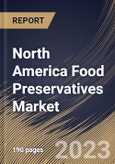The market stands at the intersection of evolving consumer preferences, technological advancements, and regulatory dynamics. The demand for industrialized and convenience foods increases in tandem with urbanization and hectic lifestyles, thereby augmenting the significance of food preservatives. This multifaceted market not only addresses the imperative of extending shelf life but also grapples with challenges arising from health-conscious consumer choices, demand for cleaner labels, and the pursuit of sustainable practices.
Moreover, in the contemporary food industry, the adoption of preservatives is ubiquitous, spanning a diverse array of products, from packaged snacks to beverages and ready-to-eat meals. Preservation is no longer solely about preventing spoilage; it is integral to ensuring food safety, meeting regulatory standards, and addressing the complexities of globalized supply chains. The adoption of preservatives has become imperative for enhancing the efficiency and reliability of food distribution systems, especially as products traverse vast distances and encounter varied climates.
North America has experienced a significant expansion in the processed food industry. An increase in demand has been observed for packaged and convenient food items, such as munchies, frozen meals, and ready-to-eat foods. As per the data from the Government of India, in 2022, the food and beverage processing industry were the largest manufacturing industry in Canada in terms of value of production, with sales of goods manufactured worth $156.5 billion. Exports of processed food and beverage products stood at a record value of $54.3 billion in 2022, an increase of 14.1% over 2021, accounting for 34.7% of production value. Thus, the growing food and beverage processing sector in North America will help expand the regional market.
The US market dominated the North America Food Preservatives Market by Country in 2022 and would continue to be a dominant market till 2030; thereby, achieving a market value of $990.7 million by 2030. The Canada market is experiencing a CAGR of 6.7% during (2023 - 2030). Additionally, The Mexico market would exhibit a CAGR of 5.8% during (2023 - 2030).
Based on Function, the market is segmented into Anti-microbial, Anti-oxidant, and Others. Based on Type, the market is segmented into Natural (Edible Oil, Rosemary Extracts, Natamycin, Vinegar, Others), and Synthetic (Sorbates, Benzoates, Propionates, Others). Based on Application, the market is segmented into Meat & Poultry Product, Bakery Products, Dairy Product, Beverages, Snacks, and Others. Based on countries, the market is segmented into U.S., Mexico, Canada, and Rest of North America.
The market research report covers the analysis of key stake holders of the market. Key companies profiled in the report include Archer Daniels Midland Company, Cargill, Incorporated, Kerry Group, Plc., Akzo Nobel N.V., Kemin Industries, Inc., Univar Solutions, Inc., Koninklijke DSM N.V., Tate & Lyle Plc., BASF SE, Celanese Corporation.
Scope of the Study
Market Segments Covered in the Report:
By Function (Volume, Kilo Tonnes, USD Billion, 2019-2030)- Anti-microbial
- Anti-oxidant
- Others
- Natural
- Edible Oil
- Rosemary Extracts
- Natamycin
- Vinegar
- Others
- Synthetic
- Sorbates
- Benzoates
- Propionates
- Others
- Meat & Poultry Product
- Bakery Products
- Dairy Product
- Beverages
- Snacks
- Others
- US
- Canada
- Mexico
- Rest of North America
Key Market Players
List of Companies Profiled in the Report:
- Archer Daniels Midland Company
- Cargill, Incorporated
- Kerry Group, Plc.
- Akzo Nobel N.V.
- Kemin Industries, Inc.
- Univar Solutions, Inc.
- Koninklijke DSM N.V.
- Tate & Lyle Plc.
- BASF SE
- Celanese Corporation
Unique Offerings
- Exhaustive coverage
- The highest number of Market tables and figures
- Subscription-based model available
- Guaranteed best price
- Assured post sales research support with 10% customization free
Table of Contents
Companies Mentioned
- Archer Daniels Midland Company
- Cargill, Incorporated
- Kerry Group, Plc.
- Akzo Nobel N.V.
- Kemin Industries, Inc.
- Univar Solutions, Inc.
- Koninklijke DSM N.V.
- Tate & Lyle Plc.
- BASF SE
- Celanese Corporation








